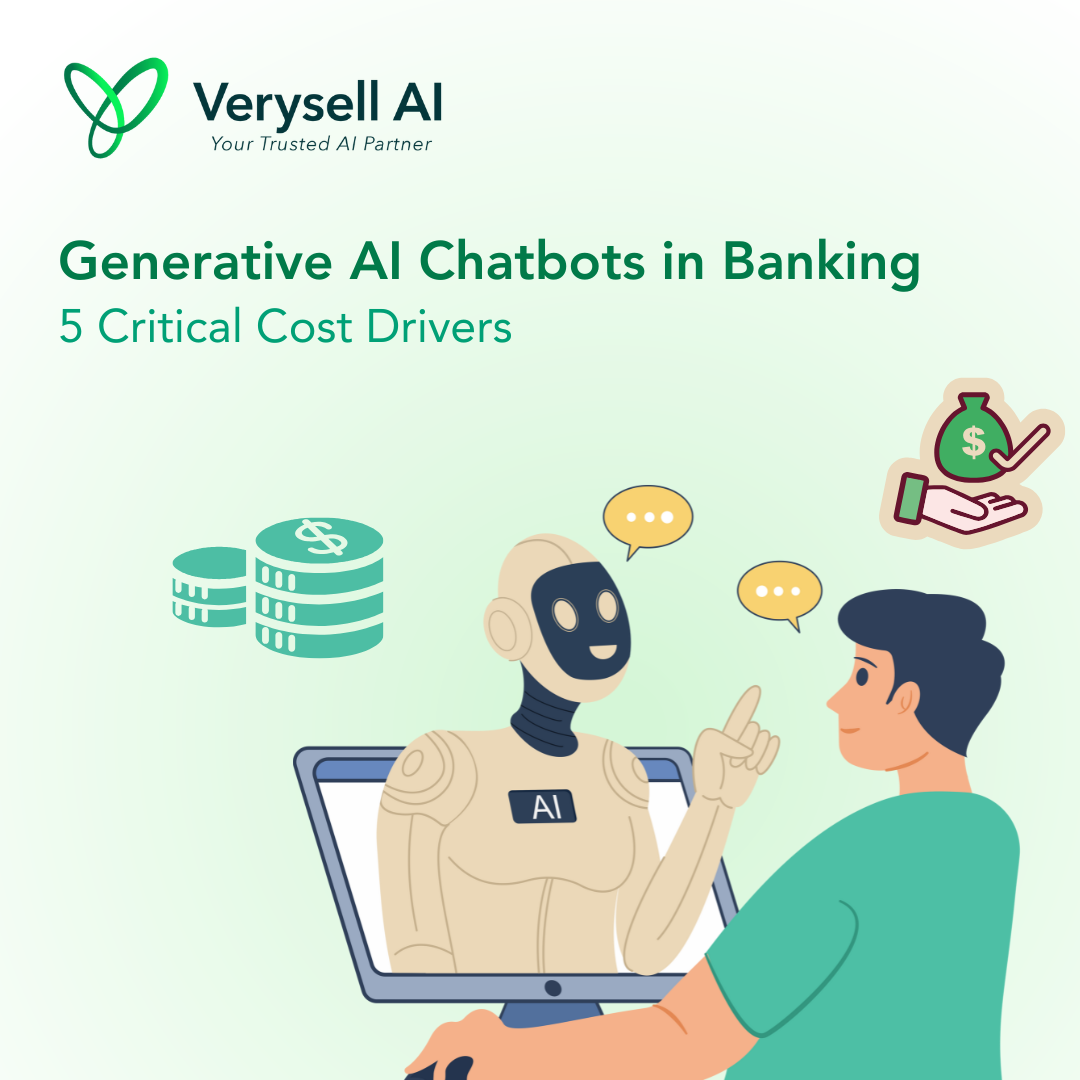The promise of Generative AI (Gen AI) in customer service is tantalizing. Imagine a chatbot that understands complex queries, provides instant, personalized answers, and even anticipates customer needs. For the banking sector, it’s about transforming the entire customer relationship. However, while the headlines might suggest that powerful AI is cheap and readily available, the reality for financial institutions is far more complex and significantly more expensive.
Developing and deploying a production-grade Generative AI chatbot for banking customer service is a substantial investment. It’s a journey that can range from an initial proof-of-concept to a fully integrated, enterprise-level solution where costs can escalate rapidly. The truth is, the cost of the AI model itself is often a surprisingly small fraction of the total budget. The real, and often underestimated, expenses lie in the intricate layers of security, integration, and compliance that are non-negotiable in the highly regulated financial industry.

Why Banking Is Different?
Before we delve into the cost breakdown, it’s crucial to understand why developing a Generative AI chatbot for banking differs from building a chatbot for a retail store. Financial services operate under a “Fort Knox” level of scrutiny, driven by unparalleled requirements.
- Zero-Tolerance for “Hallucinations”: If a general AI chatbot “hallucinates” a fact, it’s a minor error. If a banking chatbot hallucinates a bank balance, gives incorrect financial advice, or makes up a policy, it can lead to severe financial penalties, reputational damage, and lawsuits.
- Data Privacy (PII): Handling Personal Identifiable Information (PII) such as account numbers, social security numbers, and transaction details means public, off-the-shelf Gen AI models are a non-starter.
- Regulation & Compliance: Banks must adhere to a myriad of regulations, including Know Your Customer (KYC), Anti-Money Laundering (AML), and strict data-hosting laws. Every interaction must be auditable and compliant.
The pressure to deploy quickly can be a trap. A recent Forrester report warns that the rush to cut costs will cause many companies to deploy “customer-facing genAI chatbots… prematurely,” which will harm customer experience and erode trust.
This is why Gartner research is so critical: one report noted that over 90% of CIOs see cost as a major blocker to AI adoption, estimating that initial cost calculations for GenAI could be off by as much as 500% – 1,000% if not planned correctly.
The Core Cost Drivers: What You’re Really Paying For
The true cost of a Generative AI chatbot for banking is an amalgamation of several complex components.

1. AI Model & Licensing
This is the core intelligence. You can’t just use a public model.
- Commercial API-Based (Private Tenants): This is the most common approach. It involves using enterprise-grade models like Microsoft’s Azure OpenAI Service or IBM’s watsonx.ai in a private, secure cloud. The cost here is not just a one-time fee; it’s a recurring expense based on:
- Platform Fees: Enterprise plans for platforms like watsonx.ai can start from $1,050 per month plus usage.
- Inference Costs: You are billed per 1,000 tokens (inputs and outputs). A successful, high-traffic bot can generate substantial monthly bills.
- Custom Build (Open-Source Models): Developing from scratch using open-source models gives you full control but requires an elite, expensive internal team of MLOps engineers and data scientists.
2. Fine-Tuning & Retrieval-Augmented Generation (RAG)
A base model knows nothing about your bank’s specific products. This is where RAG becomes essential.
- RAG: This is the system that prevents “hallucinations.” Instead of the bot “knowing” the answer, it retrieves the correct, verified information from the bank’s internal knowledge base (e.g., policy documents, product manuals) and uses Gen AI to formulate a natural answer.
- Vector Database: Implementing RAG requires a specialized vector database. The cost isn’t just the software; it’s the ongoing cost of processing and storing your data as vectors. While component costs seem small, they add up quickly across millions of documents.
3. Secure Infrastructure & Hosting
The bot cannot reside on just any server. It needs a secure digital fortress, which means:
- Virtual Private Cloud (VPC) / On-Premise: High-cost secure cloud environments (AWS, Azure, GCP) or, for ultimate control, even more expensive on-premise hardware.
- GPU Resources: Even for inference (generating responses), GPUs are often required, adding significantly to hosting costs.
4. Compliance & Security “Guardrails”
This is a unique and non-negotiable banking cost. You must build a “guardrail” system—an additional layer of AI that intercepts every user prompt and bot response to check for:
- PII Scrubbing: Anonymizing data before it hits the LLM.
- Prompt Injection: Protecting against malicious attempts to “jailbreak” the bot.
- Compliance Checks: Ensuring the bot never provides unauthorized financial advice and always includes necessary legal disclaimers.
5. The Human Team
The highly specialized talent required for such a project commands premium salaries. This includes AI/ML Engineers, Backend Developers, Conversational UX Designers, and, critically, the billable hours of your Legal & Compliance Officers, whose time is a direct project cost.

A Baseline Cost Breakdown
While every project is different, we can establish a baseline. Research from Biz4Group, an enterprise solutions provider, breaks down the cost of developing AI-powered banking applications (which include chatbot functionality) into three tiers:
- Tier 1: Proof of Concept (Biz4Group, 2025)
- Cost: $40,000 – $80,000
- What it does: A basic chatbot that answers public FAQ questions only (e.g., “What are your branch hours?”).
- Technology: Uses a commercial model via a secure endpoint. No integrations to core systems.
- Purpose: To test the waters and gain internal confidence in Generative AI in banking.
- Tier 2: Integrated Helper
- Cost: $80,000 – $200,000
- What it does: Authenticates users. Can answer personal read-only questions (e.g., “What’s my account balance?”). It often includes features like fraud alerts.
- Technology: A robust RAG system and read-only integrations with some modern systems (like a CRM).
- Purpose: To offload common customer service queries and provide personalized information securely.
- Tier 3: Full-Scale Application
- Cost: $200,000 – $400,000+
- What it does: A more fully-featured assistant. It can answer complex queries, provide personalized insights, and integrate with multiple systems.
- Technology: Deep RAG, advanced AI-driven personalization, and multiple integrations.
- Purpose: To redefine the customer experience and create significant operational efficiency gains.
The Multi-Million Dollar Question: What About Core Banking Integration?
The $200k – $400k+ figure above is a realistic baseline for the AI application itself. However, for most established banks, this is just the tip of the iceberg. The single largest, most complex, and most expensive component is the deep integration with legacy core banking systems.
These systems are often decades old, complex, and high-risk to modify. A project to securely build, test, and deploy read/write APIs (to allow the bot to perform transactions like “transfer $500 to my savings”) is a massive undertaking. This integration project alone can easily cost $250,000 to $2,000,000+, depending on the bank’s size and the complexity of its core.
This is how a $400,000 chatbot project rapidly becomes a $2,500,000 enterprise-wide initiative.
Hidden & Ongoing Costs
The initial development cost is just the beginning. Be prepared for:
- Model Maintenance & Retraining: Your bank’s policies and products change constantly. The RAG knowledge base must be continuously updated.
- Inference Costs: You pay for every single query a customer makes. A highly successful chatbot can generate substantial monthly bills.
- Human-in-the-Loop (HITL): A team of human agents is essential to monitor bot conversations, flag errors, and provide feedback to the AI team.
- Ongoing Security & Compliance Audits: Mandatory, frequent, and expensive.
The journey to deploy Generative AI in banking is complex and costly. But with reports from McKinsey & Company suggesting AI can reduce operational costs by 20-30%, it’s not merely an expense; it’s a strategic investment in the future of personalized customer relationships and operational resilience.
Conclusion: An Investment, Not an Expense
The journey of Generative AI chatbot development for banking is undeniably complex and carries a significant price tag. As we’ve detailed, the budget isn’t consumed by the AI models themselves, but by the non-negotiable “Fort Knox” of security, the intricate integration with legacy core banking systems, and the rigorous demands of regulatory compliance.
The figures, which can escalate from a $50,000 proof-of-concept to a $5 million+ fully transactional system, can be daunting. However, in this new digital-first era, the greatest financial risk is not the cost of investment, but the cost of inaction.
As competitors and agile fintech startups deploy Generative AI in banking to offer 24/7, hyper-personalized, and efficient customer service, the institutions that delay will be left competing on outdated terms. Ultimately, this project should not be viewed as a “customer service cost.” It is a foundational, strategic investment in operational efficiency, next-generation customer relationships, and long-term competitive resilience.
Start Your Transformation with Confidence
Navigating the complex landscape of Generative AI in banking is a monumental challenge. You don’t have to do it alone.
Contact Verysell AI today for a consultation and let us help you build your roadmap from pilot to production.


